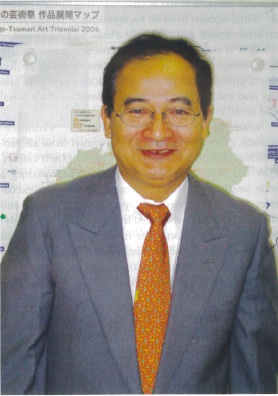by Kirk Patterson
Fram Kitagawa was born and raised in Niigata Prefecture. A “regional coordinator,” he has just completed his third Echigo-Tsumari Art Triennial, the largest international art event in the world, in which artists from around the world create site-specific works in rural Niigata.
Please tell me a bit about your background and current activities.
After graduating from high school, it took me a while to get my life on track, entering the Tokyo University of Art and Music at the age of 21 and graduating when I was 27. Since then, I have never worked in a company, instead preferring to work independently by forming teams to help organize events.
Over the years, I have organized many events, mainly art-related but also some music and theatrical events. My first large-scale production was an Antoni Gaudi exhibition, which traveled around 11 Japanese cities in 1978-79.
In addition to producing art events, I am also actively involved in town planning projects, seeking ways to make art part of the urban landscape. In addition, I manage an art gallery and am a professor at Joshibi University of Art and Design.
What is the philosophy that underlies your approach to art?
Art is not just something to look at, but rather art is like a child. It is weak and so it has to be nurtured and developed by people working together. Art is a process that requires involvement by others. At the same time, artists, especially in Japan, are both too market-oriented and too isolated from the real world.
Art…is weak and so it has be nurtured and
developed people working together
I feel that people need to have more opportunities to discuss art; to experience art. Art has to reach out to people, rather than wait to be discovered by people. Art can be used to create and revitalize communities.
Is that what led you to the Echigo-Tsumari Art Triennial?
Yes, but it was not an easy process. Niigata Prefecture approached me in 1996 about doing something creative to facilitate the merger of towns in the Echigo-Tsumari area. This is a very rural region that is experiencing severe depopulation. My idea was to try to help reinvigorate the area—or at least to give residents a renewed sense of pride and engagement—by inviting artists from Japan and other countries to create works of art throughout the region, which covers an area larger than the 23 wards of Tokyo. Although art is often considered an element of an urban lifestyle, to me the land is a huge canvas on which artists can apply their creative talents in various unique ways.
The local residents, however, were not interested in my idea. They couldn’t understand it, and they thought it was too much trouble. I spent four and a half years crisscrossing the region, attending over 2,000 meetings with residents. Finally, I was able to get their involvement, so we launched the Echigo-Tsumari Art Triennial.
The first event was held in 2000 and brought together 148 artists from 32 countries. The second was held in 2003, with 157 artists horn 23 countries. And the third, held from July to September 2006, featured 330 artists from 47 countries and attracted 350,000 visitors.
From initially being very skeptical about the project, the local residents gradually became very engaged. They helped artists create their works of art and they take care of many of the artworks after the festival ends. These works are scattered throughout nature, deep in forests, overlooking mountain panoramas, and nestled alongside rice paddies. Many of the creations are left behind to become integrated into the landscape.
What has been the result of the Echigo-Tsumari Art Triennial?
It is being recognized in three different ways. First, it has brought renewed appreciation of satoyama, the unique landscape, aesthetics, and lifestyle of rural Japan. Second, it has highlighted the failings of urban art, which is often uninteresting, difficult to understand, and far removed from daily life. Finally, it has shown how people of diverse backgrounds—artists and farmers, young and old, urban and rural—can come together in collaborative, not combative, ways.
What lies ahead for you?
Producing the Echigo-Tsumari Art Triennial will continue to occupy most of my time and energy. I will, however, get involved in a project to help revitalize the Seto Inland Sea area. This will begin in 2007, starting off with discussions with local residents. I am not sure what we will end up doing, but it will almost certainly involve art in some way or other.
External Link:
Echigo-Tsumari Art Triennale









